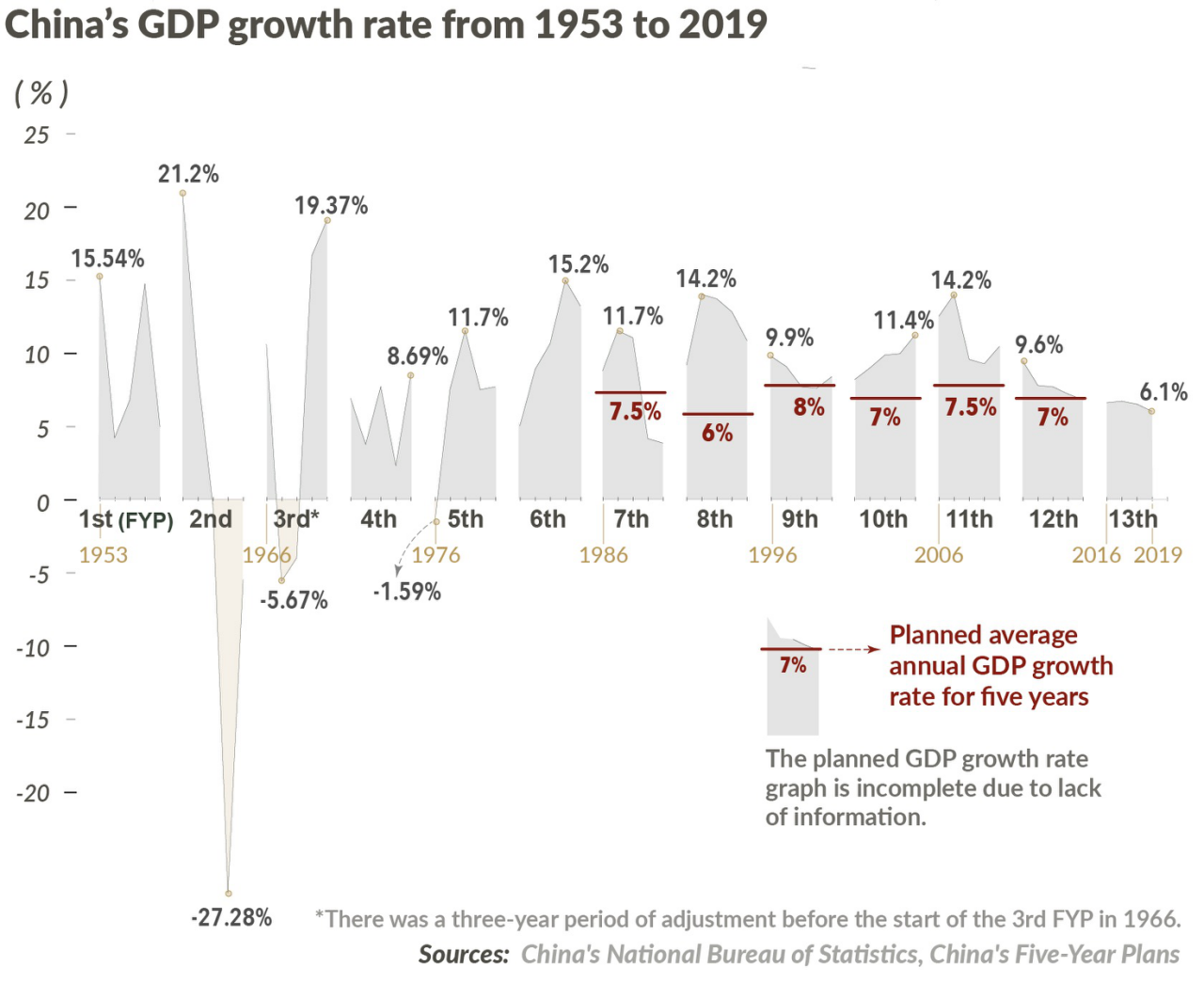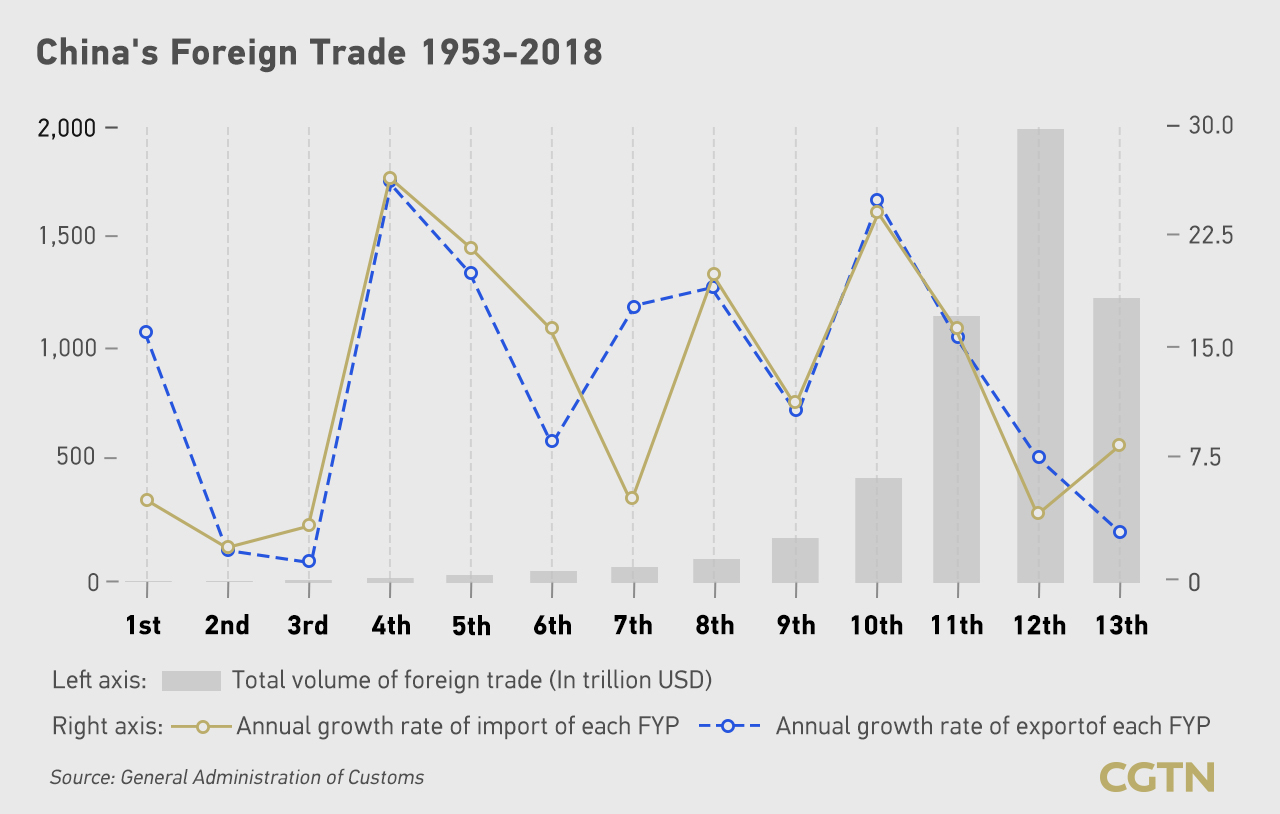The Five-Year Plans for National Economic and Social Development, or the Five-Year Plans (FYP) in short, are a series of initiatives issued since 1953 in China to map the direction of future development, in which international trade serves as an indispensable part.
China's foreign trade had been enslaved to the trade policies of Western powers due to historical reasons, but after the founding of the People's Republic of China (PRC) in 1949, the country implemented foreign trade control and trade protection policies, fundamentally changing the semi-colonial and semi-feudal nature of foreign trade and establishing independent foreign trade that serves the interests of the people and socialist cause.
On the basis of equality, mutual benefit and cooperation, China quickly developed trade ties with the former Soviet Union and a raft of democratic countries. Through this new type of foreign trade, China received tremendous help from people's democracies, especially the former Soviet Union. This has played an extremely important role in restoring China's national economy and preparing and implementing the first five-year plan.
People's democracy: A country or form of government in transition from a multi-party democracy to socialism.
Against such a backdrop, the first FYP (1953–1957) proposed to beef up the country's economic cooperation with the socialist camp led by the former Soviet Union and expand trade with democratic countries. It also highlighted that trade with the former Soviet Union and the democratic countries is a solid foundation for fulfilling China's five-year import and export mission and ensuring the continued development of foreign trade.

Reform and opening-up (From the 7th to the 9th FYP)
In December 1978, the late Chinese leader Deng Xiaoping initiated the country's reform and opening-up policy. This policy jump-started China's transformation from an underdeveloped centrally-planned economy into an economic powerhouse that is increasingly driven by the market. Since then, China has witnessed drastic changes and remarkable achievements in a diverse range of spheres.
The 7th FYP (1986-1990) put reform at the top of the agenda and coordinated economic development with reform. It explicitly stated that the construction or opening-up of special economic zones and coastal cities should be expedited to lay a solid foundation for the country's foreign trade. It also said the total import and export volumes should go up by 35 percent within the next five years, while expanding the scale of foreign investment and advanced technology.
Average annual trade growth remained less than 10 percent from 1950 to 1977 under the planned economy, but quickened to about 14.5 percent after China started the reform and opening-up drive in 1978.
During the 8th FYP (1991-1995), the country continued to stick to the basic state policy of opening-up, doing so even more broadly to the outside world and speeding up the building of a new open economy, embracing the transition from exporting raw materials and less manufactured products to those that are more manufactured.
China's economy experienced an annual growth of 11 percent during the period, which was 4 percentage points higher than that during the 7th FYP. By the last year of the 8th FYP, the overall pattern of opening-up to the outside world had essentially taken shape, with foreign trade growing rapidly and the use of foreign capital surging substantially.
One of the most pronounced problems China encountered in the time of the 9th FYP (1996-2000) was insufficient domestic demand. Out of relatively lackluster domestic market demand and economic growth constrained by demand, export as an important aspect of final demand is instrumental in driving domestic production growth.
Hence the country adhered to the foreign trade strategy of outperforming in terms of the quality of goods and market diversification. It further optimized the structure of import and export commodities and reduced the tariff rate to the average of developing economies during the 9th FYP.

Accession to the WTO (From the 10th to the 13th FYP)
After 15 years of negotiations, China became a member of the World Trade Organization (WTO) on 11 December 2001. Risks always coexist with opportunities. Opportunities are fair to everyone, but not all of us can catch them.
With the further expansion of the market and the substantial reduction of customs clearance tax, foreign products, services and investments were more likely to enter the Chinese market, and some domestic products, enterprises and industries would inevitably face more intense competition.
In response to such drastic changes, the 10th FYP (2001-2005) requested to adapt to the new requirements that needed to be met after joining the WTO and paying close attention to the formulation and improvement of relevant foreign country-related laws and regulations.
Absorbing foreign capital strongly shored up domestic economic construction. In the time of the 10th FYP, the country's actual use of foreign capital exceeded 286.1 billion U.S. dollars, 1.34 times that of the 9th FYP period and foreign investment accounted for about 8.5 percent of total social fixed asset investment.
As of the end of November 2006, nearly 590,000 foreign-invested enterprises had been established throughout China, with the actual use of foreign capital settling at 676.6 billion U.S. dollars. Nearly 200 countries and regions had invested in China by that time, and about 480 of the world's top 500 companies made a foray into the country.
The latest three FYPs, or rather, the 11th (2006-2010), 12th (2011-2015) and 13th FYPs (2016-2020), all shed light on foreign trade, calling for speeding up foreign trade transformation and upgrade while optimizing its foreign trade structure.
China overtook the United States to become the world's largest goods trading country in 2013 for the first time.
In 2019, China's economy grew 6.1 percent, according to official figures. The number is in tandem with the target range of 6.0 to 6.5 percent projected in the previous year. It came in as the slowest pace since 1990. But it is still one of the fastest rates of economic growth around the world in a lackluster global economical environment dragged down by the wildcards of geopolitical tensions and tit-for-tat tariffs.
The country's foreign trade edged down one percent for all of 2019 to settle at an all-time high of 4.6 trillion U.S. dollars, with exports climbing 0.5 percent and imports contracting 2.8 percent. This resulted in a trade surplus of 421.5 billion U.S. dollars, 25.4 percent higher from a year earlier, the third highest since 1950, 2015, and 2016.